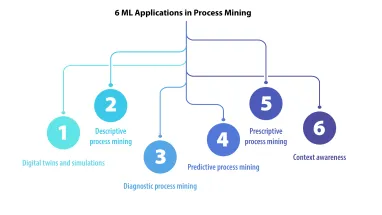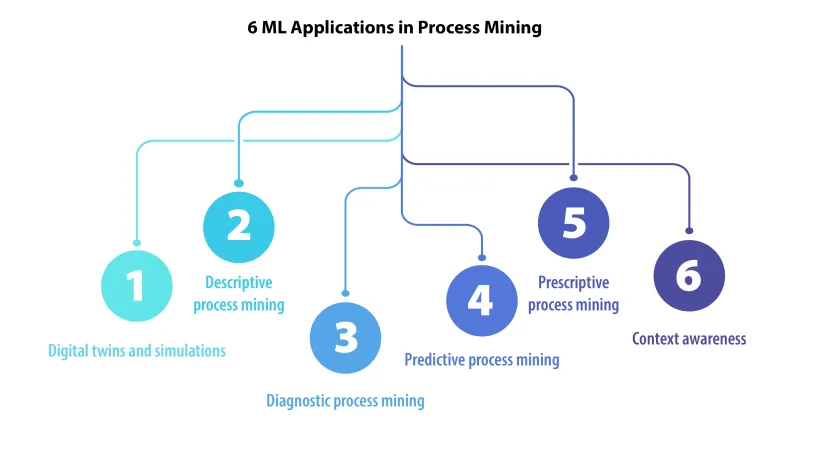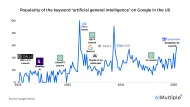For more than a decade, machine learning has been applied to traditional process mining 1 . Today, many vendors claim to offer AI-powered process mining software which leverages machine learning. Yet, clients do not know how the AI features are integrated into process mining, making it difficult for business leaders to understand the benefits and use cases of process mining with machine learning.
In this article, we clarify how process mining can leverage ML, and which applications can benefit from AI-enabled process mining.
Does process mining use AI?
Traditional process mining tools do not leverage AI, however, some vendors integrate artificial intelligence features such as machine learning and deep learning to automate collection, discovery, visualization and monitoring of process data in IT systems.
AI-enabled process mining, also known as intelligent process mining, can enhance the features of different applications such as digital twins and predictive analytics which rely on regular process mining capabilities.
Digital twins and simulations
ML can be leveraged in process mining applications such as digital twins and digital twin of an organization where businesses simulate products and existing business processes in order to estimate success and error rates.
Explore more on how to benefit from process simulation or use process mining & digital twins together.
Descriptive process mining
- Cluster similar cases under one group.
- Detect outliers.
- Evaluate issues and learn to find similar errors based on training data.
Descriptive processes are used to understand business operations data. One example is lead time data in manufacturing sector.
Automated process discovery
Process discovery attribute enables users to analyze and visualize their process data. Today, some vendors offer process discovery tools that leverage AI technologies and algorithms to automate discovering workflows and generating a process model, known as automated process discovery. Automated process discovery can also help with identification of human interaction by employing computer vision.
Explore our detailed articles on automated process discovery tools and leading vendors.
Diagnostic process mining
Diagnostic process mining refers to process diagnostics method to:
- Analyze issues to find the root causes.
- Classify problems into categories.
- Capture the trend in process change over time.
Diagnostic processes are applied to find a problem in a process. For example, in delivery systems, diagnostic process mining detects conforming and non-conforming cases with the root of the problem in the relevant regions.
Automated root-cause analysis
Process mining vendors leverage machine learning algorithms, such as anomaly detection, to offer automated root-cause analysis. These algorithms typically calculate correlations and splits the data accordingly to provide user-friendly diagrams. Learn more on how process mining uses automated root cause analysis.
Predictive process mining
Predictive process mining forecasts case outcomes by analyzing key performance indicators (KPIs).
Predictive processes are useful as they predict future issues by relying on the current information. In delivery services, processes mining predicts for On-Time Delivery (OTD). It utilizes already existing customer order list to estimate expected delivery times and possible delays.
Read and learn more on top 3 predictive process mining use cases and predictive process monitoring.
Prescriptive process mining
- Sends notifications and alerts to users.
- Initiates RPA, workload automation, and different business workflows.
- Updates enterprise resource planning (ERP and SAP) systems.
After predicting potential issues, prescriptive process mining offers recommendations to address and capitalize on them. To continue with the delivery example, the OTD can be hyperlinked to the email system to send an email to customers in cases of delays.
Companies generally implement process mining with all these categories since they want to understand processes, detect problems, predict future issues, and prevent them in time. However, prescriptive process mining is still in progress compared other three types as process mining trends indicate. Yet, the future of process mining will provide more actionable platforms than now.
Context awareness
Another application of ML in process mining is context awareness, which is a system component to collect information about entity’s environment. Context awareness recognize the context and uses this information.
Event logs may store extra data such as timestamps, order size, related persons, etc. These additional information are called context-related information. In some sectors (e.g., logistics and manufacturing), the frequency of a process or the entire cycle is included in event logs as context information.
This additional information can be extracted from event logs while grouping similar events or estimating frequency. However, they can be crucial to determine errors in a process. Therefore, storing such additional information needs to be taken into account to ensure quality of processes.
Machine learning is a context-aware system. It detects similarities between items in large data sets and categorizes them according to the respected context. As a result, it provides convenient help or information concerning a user’s task. Applying machine learning and process mining together provides critical context awareness for unstructured event data which can improve the results of process mining.
Recommendation to business
According to process mining trends, AI applications in process mining remains limited despite growing interest. This is because businesses still struggle with data integration problems, limiting them from leveraging AI capabilities that require extensive quality data.
Companies can tackle the integration problem by putting their data on cloud or a data warehouse. By leveraging warehouse automation tools, companies can ease their process to consolidate their data and start applying process mining for process improvement.
Besides, business leaders need to determine whether they need for intelligent process mining software. One way to understand it is to evaluate by deploying open source process mining tools or free trials from top vendors.
- Read our curated articles to help you identify the best open source process mining tools and vendors offering free trials:
- Discover how to compare process mining software that you apply to your businesses:
- Explore process mining market inside out with the latest criteria and reports:
For more on process mining
To explore more how AI and ML improves process mining today and for the future, feel free to read our articles:
And if you believe your business will benefit from a process mining solution, feel free to scroll down our data-driven list of process mining software.
Explore alternative solutions such as:
- The digital twin of an organization (DTO)
- Process modeling
- Process analysis tools
- Automated process discovery tools.




Comments
Your email address will not be published. All fields are required.